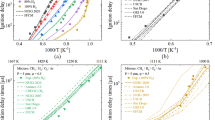On the basis of thermodynamic calculations, the features of the combustion of a solid-fuel mixture based on the glycidyl azide polymer were investigated, the thermal cycle of the combustion chamber of a model engine system was analyzed, and the efficiency of this chamber was determined for a wide range of pressures in it and different ratios between the components of the combustible mixture. It was established that, when the pressure in the combustion chamber of an engine system increases, two maxima arise successively on the dependence of the thermal efficiency of the chamber on the weight fractions of the components of the combustible mixture and that the first maximum shifts to the side of smaller concentrations of the glycidyl azide polymer with increase in the pressure in the chamber; the position of the second maximum is independent of this pressure, coincides with the minimum on the dependence of the rate of combustion of the mixture, and corresponds to the point of its structural phase transition at which the mole fractions of the carbon and oxygen atoms in the mixture are equal. The results obtained were interpreted on the basis of the Le-Chatelier principle.
Similar content being viewed by others
References
M. W. Beckstead, K. V. Puduppakkam, P. Thakre, and V. Yang, Modeling of combustion and ignition of solid-propellant ingredients, Prog. Energy Combust. Sci., 33, 497–551 (2007).
K. V. Puduppakkam, M. W. Tanner, and M. W. Beckstead, RDX/GAP pseudo-propellant combustion modeling, in: Proc. 42 nd AIAA/ASME/SAE/ASEE Joint Propulsion Conf., July 9–12, 2006, Sacramento, California (2006), Vol. 7, pp. 5755–5767.
J. E. Flanagan, D. O. Woolery, and R. L. Kistner, Combustion characteristics of GAP/RDX gumstocks, in: Proc. 24 th JANNAF Combust. Meeting, October 5–9, 1987, Monterey, California (1987), Vol. 3, pp. 29–38.
E. S. Kim, V. Yang, and Y. C. Liau, Modeling of HMX/GAP pseudo-propellant combustion, Combust. Flame, 131, 227–245 (2002).
L. K. Gusachenko and V. E. Zarko, Analysis of models of combustion of energy substances with entirely gaseous reaction products, Fiz. Goreniya Vzryva, 41, No. 1, 24–40 (2005).
D. H. Lewis Jr., S. W. Janson, R. B. Cohen, and E. K. Antonsson, Digital micropropulsion, Sensors Actuators A, 80, 143–154 (2000).
C. Rossi, D. Mehdi, and D. Estève, Pyrotechnic actuator: a new generation of Si integrated actuator, Sensors Actuators A, 74, 211–215 (1999).
S. I. Futko, E. M. Ermolaeva, K. V. Dobrego, V. P. Bondarenko, and L. N. Dolgii, Thermodynamic analysis of solid-fuel mixtures glycidyl azide polymer (GPA)/RDX for mini-engines of microelectromechanical systems, Inzh.-Fiz. Zh., 84, No. 5, 990–995 (2011).
S. I. Futko, V. P. Bondarenko, and L. I. Dolgii, Analysis of momentum characteristics of the miniengine of a microelectromechanical system operating on a solid mixed propellant, Inzh.-Fiz. Zh., 85, No. 1, 145–150 (2012).
S. I. Futko, V. P. Bondarenko, and L. N. Dolgii, Method for characterizing and choosing the solid mixed fuel for microthrusters of microelectromechanical systems, Inzh.-Fiz. Zh., 85, No. 3, 520–525 (2012).
S. I. Futko, V. P. Bondarenko, L. N. Dolgii, K. V. Dobrego, A. Klyshko, E. Chubenko, and A. Shevel, Experimental and theoretical study of thrust characteristics of novel MEMS microthruster on solid-fuel mixtures, in: Proc. 6th European Combust. Meeting, June 25–28, 2013, Lund, Sweden (2013). Paper P5–82, 6 pp., ISBN 978-91-637-2151-9.
S. I. Futko, Thermodynamic substantiation of the existence of a phase transition point with a change in the structure of the solid-fuel mixture glycidyl azide polymer (GPA)/RDX, Inzh.-Fiz. Zh., 85, No. 5, 974–981 (2012).
R. J. Kee, F. M. Rupley, and J. A. Miller, Chemkin II: a Fortran Chemical Kinetics Package for the Analysis of Gas Phase Chemical Kinetics, Report SAND89-8009, Sandia National Lab. (1989).
M. E. Coltrin, R. J. Kee, F. M. Rupley, and E. Meeks, Surface Chemkin III: a Fortran Package for Analyzing Heterogeneous Chemical Kinetics at a Solid-Surface–Gas-Phase Interface, Report SAND96-8217, Sandia National Lab. (1996).
V. E. Alemasov, The Theory of Rocket Engines [in Russian], Mashinostroenie, Moscow (1962).
Author information
Authors and Affiliations
Corresponding author
Additional information
Translated from Inzhenerno-Fizicheskii Zhurnal, Vol. 87, No. 6, pp. 1261–1268, November–December, 2014.
Rights and permissions
About this article
Cite this article
Futko, S.I., Koznacheev, I.A. & Ermolaeva, E.M. Influence of the Structure of a Solid-Fuel Mixture on the Thermal Efficiency of the Combustion Chamber of an Engine System. J Eng Phys Thermophy 87, 1313–1321 (2014). https://doi.org/10.1007/s10891-014-1134-x
Received:
Published:
Issue Date:
DOI: https://doi.org/10.1007/s10891-014-1134-x




